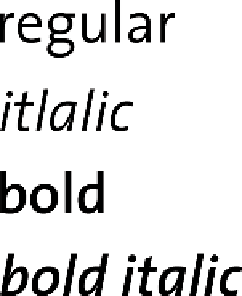Graphics Programs Reference
In-Depth Information
Many people rely on pictures to tell a story, but
there's just no getting around the use of type.
Sure, a picture of a bus on a street sign would
clue most into realizing they were standing at a
bus stop, but you couldn't stop there. Without
accurate use of a few letters and numbers, you'd
have little confidence in the route or timing of
the service. It is proper use of type that designers
must rely on to communicate vital information
to audiences. If you can combine this functional
purpose with a better sense of style and control, you can improve
the professional appearance of your designs.
Font choice can be a very tough decision for you if you are a new
designer. You can easily become overwhelmed with the sheer quan-
tity of options. To simplify the process, you need to approach this
decision with a triage mentality and consider a few guiding questions:
•
Readability. Is the font clear to read at the size you are using
it? Are all the characters in the line readable? If you look at it
quickly and then close your eyes, what do you remember about
the text block?
•
Style. Does the font convey the right emotion for your design?
The text on an action movie poster is very different from that
advertising the latest romantic comedy. Type is a like wardrobe;
picking the right font is essential to the success of the design.
•
Flexibility. Does the font mix well with others? Does it come
in various weights (such as bold, italic, and book) that make it
easier to convey significance when using that font?
These are my three guiding principles, but there are other con-
straints at play as well that require much more analysis. It's a good
idea to formally study typography if you want to work in a design
field professionally. At the bare minimum, you can at least read
a few topics. I strongly recommend
The Mac Is Not a Typewriter
(Peachpit Press, 2003) by Robin Williams and
Stop Stealing Sheep &
Find Out How Type Works
(Adobe Press, 2002) by Erik Spiekermann
and E.M. Ginger. But for now, let's go over the essentials.




